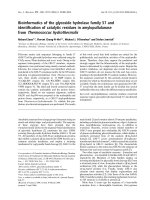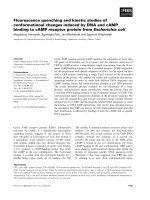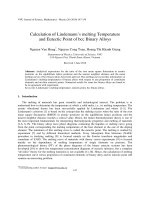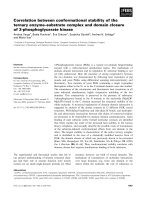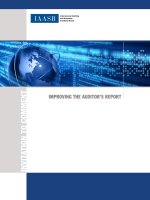The auditor's loss function and investors' perceptions of audit effectiveness Effects of regulatory change
Bạn đang xem bản rút gọn của tài liệu. Xem và tải ngay bản đầy đủ của tài liệu tại đây (643.41 KB, 84 trang )
THE AUDITOR’S LOSS FUNCTION AND
INVESTORS’ PERCEPTIONS OF AUDIT
EFFECTIVENESS: EFFECTS OF REGULATORY
CHANGE
by
Jason Lance Smith
_________________________________
A Dissertation Submitted to the Faculty of the
COMMITTEE ON BUSINESS ADMINISTRATION
In Partial Fulfillment of the Requirements
For the Degree of
DOCTOR OF PHILOSOPHY
WITH A MAJOR IN MANAGEMENT
In the Graduate College
THE UNIVERSITY OF ARIZONA
2008
UMI Number: 3297968
3297968
2008
UMI Microform
Copyright
All rights reserved. This microform edition is protected against
unauthorized copying under Title 17, United States Code.
ProQuest Information and Learning Company
300 North Zeeb Road
P.O. Box 1346
Ann Arbor, MI 48106-1346
by ProQuest Information and Learning Company.
2
THE UNIVERSITY OF ARIZONA
GRADUATE COLLEGE
As members of the Dissertation Committee, we certify that we have read the dissertation
prepared by Jason L. Smith entitled The Auditor’s Loss Function and Investors’
Perceptions of Audit Effectiveness: Effects of Regulatory Change and recommend that it
be accepted as fulfilling the dissertation requirement for the Degree of Doctor of
Philosophy.
_______________________________________________________________________ Date: April 15, 2008
William L. Felix, Jr.
_______________________________________________________________________ Date: April 15, 2008
Jeffrey W. Schatzberg
_______________________________________________________________________ Date: April 15, 2008
William S. Waller
Final approval and acceptance of this dissertation is contingent upon the candidate’s
submission of the final copies of the dissertation to the Graduate College.
I hereby certify that I have read this dissertation prepared under my direction and
recommend that it be accepted as fulfilling the dissertation requirement.
________________________________________________ Date: April 15, 2008
Dissertation Director: William L. Felix, Jr.
3
STATEMENT BY AUTHOR
STATEMENT BY AUTHORSTATEMENT BY AUTHOR
STATEMENT BY AUTHOR
This dissertation has been submitted in partial fulfillment of requirements for an
advanced degree at the University of Arizona and is deposited in the University Library
to be made available to borrowers under rules of the Library.
Brief quotations from this dissertation are allowable without special permission, provided
that accurate acknowledgment of source is made. Requests for permission for extended
quotation from or reproduction of this manuscript in whole or in part may be granted by
the head of the major department or the Dean of the Graduate College when in his or her
judgment the proposed use of the material is in the interests of scholarship. In all other
instances, however, permission must be obtained from the author.
SIGNED: Jason Lance Smith
4
ACKNOWLEDGEMENTS
I express gratitude to my dissertation committee – William L. Felix, Jr. (chair),
Jeffrey Schatzberg, and William S. Waller – for their guidance and support. I
appreciate helpful comments by Bill Messier, Kristian Mortenson, Lisa Ordoñez, Lisa
Sedor, Chad Simon, Nathan Stephens, David Wood, Arnie Wright, and workshop
participants at the University of Arizona, Georgia State University, University of
Houston, University of Nevada – Las Vegas, Northeastern University, University of
Texas at Arlington, and Virginia Tech for their valuable comments. I also thank the
M.B.A. students who participated in the experiment described in the paper. All errors
are my own.
5
DEDICATION
I dedicate this work to those whose loving support made its completion possible.
First, to my wife and eternal companion, Lena, and to our greatest works: Rachel,
Tyson, and Easton. To my parents, Lance and Naomi, whose unconditional and life-
long support have shaped me into the person I am today. To my siblings – Andrea,
Jacqueline, and Ryan – who are my greatest friends. Finally, to a loving Father in
Heaven who has provided me with everything I have.
6
TABLE OF CONTENTS
ABSTRACT 7
1. INTRODUCTION 8
2. REGULATORY BACKGROUND 14
2.1 From Auditing Standard 2 (AS2) to Auditing Standard 5 (AS5) 14
2.2 Limiting Auditor Liability Exposure 17
3. HYPOTHESIS DEVELOPMENT 21
3.1 Experimental Manipulation Checks 22
3.2 Hypothesis 1: Audit Effectiveness 22
3.2.1 AS5: Improving Efficiency without Reducing Effectiveness? 22
3.2.2 Litigation Reform: Reducing the Auditor’s Liability Exposure 24
3.3 Hypothesis 2: Implications for Investments in Internal Control 28
3.4 Hypothesis 3: Implications for Investing Decisions 29
4. EXPERIMENTAL METHOD 31
5. RESULTS 36
5.1 Post-Experimental Manipulation Checks 36
5.2 Descriptive Statistics 36
5.3 Tests of Experimental Manipulation Checks and Hypotheses 37
5.3.1 Manipulation Check 1: Perceived Cost of an Audit Failure 37
5.3.2 Manipulation Check 2: Amount of Auditor Testing in Performing the
Audit of Internal Controls 38
5.4 Test of Hypothesis 1: Perceptions of Audit Effectiveness 39
5.5 Test of Hypothesis 2: Management’s Investment in Internal Control 40
5.6 Test of Hypothesis 3: Stock Price Prediction and Investment Allocation 41
6. ADDITIONAL ANALYSIS 44
7. CONCLUSIONS, LIMITATIONS, AND FUTURE RESEARCH 47
APPENDIX A 50
APPENDIX B 69
REFERENCES 81
7
ABSTRACT
In this dissertation, I examine the effects of regulatory changes that affect the
auditor’s loss function on investors’ perceptions of audit effectiveness. Specifically, I
examine two changes intended (1) to improve audit efficiency and (2) to reduce
auditor liability exposure. The first regulatory change, which was recently enacted, is
the replacement of Auditing Standard 2 (AS2) with Auditing Standard 5 (AS5). The
second regulatory change, which is currently a hypothetical change, is the passage of
litigation reform aimed at limiting the auditor’s liability exposure following an
alleged audit failure. I examine perceived audit effectiveness rather than actual
effectiveness because actual audit effectiveness is unobservable by investors. In an
experiment using 101 MBA students as proxies for individual investors, I find that
both changes are perceived by investors as reducing the amount of testing performed
by the auditor when performing the internal control audit. I also find that both
regulatory changes negatively affect investors’ perceptions of audit effectiveness.
Following the change in the auditing standard, experienced and inexperienced
investors predict opposite stock price movement and, as a result, make different
investment allocation decisions. In performing supplemental analyses, I find
significant gender differences in predicted future stock prices, but not in perceptions
of audit effectiveness or in perceptions of internal control quality.
8
1. INTRODUCTION
Public auditors provide a critical service to the world’s capital markets. Without
high-quality audits, managers would face a high agency cost (Jensen & Meckling 1976)
and investors would be less confident in corporate disclosures (Libby 1979, Hodge 2001).
Regulators and legislators attempt to create and enforce standards and laws that provide
assurance to investors of high-quality audits and provide significant penalties to auditors
for low-quality audits. Those same regulators and legislators must also consider and
balance the relative costs of providing audits so standards and laws are not overly
burdensome and costly.
This study investigates the effects of two regulatory changes in the auditing
environment on individual investors’ perceptions of audit effectiveness. Specifically, I
investigate how (1) the recently enacted change to the auditing standard governing annual
audits of internal control of public companies and (2) a plausible but hypothetical change
to the auditor’s legal liability exposure affect investors’ perceptions of audit effectiveness
and their investment allocation decisions.
I use these two regulatory issues – one actual and one theoretical – because they
both represent significant changes in the auditing environment that have been approved
or are being discussed by regulators and legislators in popular business news publications
and in other public forums. In addition, both changes used in this study affect the
auditor’s loss function for an integrated audit engagement. For the purposes of this
paper, I define the auditor’s loss function in the following equation:
Auditor Profit (Loss) = Audit Fee - Cost of Audit - Expected Litigation Cost
9
That is, for a given audit engagement of a public company, the auditor receives a
fee, must perform a costly audit of the company’s internal control over financial reporting
(ICFR) and of the company’s financial statements, and the auditor is exposed to some
litigation risk as a result of issuing opinions on ICFR effectiveness and on the financial
statements. The two changes I examine in this study affect each of the two costs
associated with this function.
The first change represented in this experiment – the change in auditing standards
from Auditing Standard 2 (AS2) to Auditing Standard 5 (AS5) – affects the auditor’s cost
of performing the ICFR audit and has recently been approved and enacted in the United
States (PCAOB 2007a).
1
Interested parties on both sides of this issue have lobbied for
and against this change in the auditing standard, but because this change has only
recently been adopted, no empirical data are available regarding the effects of its
implementation. The second change represented in this study – litigation reform limiting
auditors’ liability following an alleged audit failure – affects the auditor’s expected
litigation cost associated with an engagement and is an abstract representation of changes
currently being considered within the U.S. and internationally. These two issues have
come to the forefront of the regulatory debate in auditing over the past few years, and any
approved changes may be expected to have significant effects on the world’s capital
markets.
1
In the experimental materials, the two auditing standards are not named; they are described as the existing
standard and the proposed standard. For expositional purposes, I refer here to the two standards presented
in the experimental setting as AS2 (the existing standard) and AS5 (the proposed standard).
10
I recognize that actual and perceived audit effectiveness may be different and are
both empirically important and interesting. In this study, I choose to examine investors’
perceptions of audit effectiveness rather than actual audit effectiveness because actual
audit effectiveness is generally unobservable to individual investors and is not known
until after investors make allocation decisions. As such, perceptions of audit
effectiveness – not empirical measures of actual audit effectiveness – are likely
considered by investors when making investment allocation decisions.
I use an experimental approach in this study for two reasons. First, because the
two changes of interest in this study have not been implemented together, some of the
regulatory environments of interest do not currently exist in a natural setting. An
experimental study has the potential to provide ex ante evidence of possible
consequences of implementing changes of this nature (Libby et al. 2001). My
experiment not only provides early feedback to audit regulators regarding the effects of
the recent change to AS5, but it also provides interesting evidence regarding the possible
effects of an environment where both changes are adopted. The second reason I chose to
use an experiment in this study is because I examine the regulatory changes’ effects on
individual investors’ judgments, perceptions, and decisions. Whereas archival
methodologies observe aggregate decision outcomes, an experimental design allows
researchers to better understand the judgment and decision-making processes of
individuals. The current experimental design allows me to examine the individual and
combined effects of two plausible regulatory changes on individual investors’ perceptions
and decision-making processes.
11
In the experiment, 101 Executive and Evening MBA student participants serve as
proxies for individual investors. Prior research provides evidence that MBA students –
particularly Executive MBA students – serve as reasonable proxies for individual
investors (Elliott et al. 2007). The participants review and consider information about an
investment allocation decision involving a publicly-traded company and a risk-free
alternative.
2
After reviewing relevant background and financial information, participants
provide preliminary judgments regarding audit effectiveness and financial statement
reliability for the company and make a 12-month stock price prediction and investment
allocation decision based on the provided information. Participants then read about
regulators’ and legislators’ decisions to implement or reject changes in the auditing
standard and changes in the auditor liability laws and provide revised judgments and a
revised investment allocation decision.
3
I examine both within- and between-subject differences to understand the effects
of these regulatory changes on participants’ perceptions and decisions regarding audit
effectiveness.
Those lobbying for a change in the auditing standard governing the ICFR audit
have indicated that a new risk-based standard would improve audit effectiveness and
would free up management resources (i.e., time, cash) to perform other value-adding
activities to help improve the organization. In approving AS5, regulators have accepted
this argument and have expressed confidence that the new standard will improve
2
In order to provide a plausible alternative to investing in the public company, participants are also
presented with the option of allocating funds to an FDIC-insured certificate of deposit (CD) account.
3
For expositional purposes, I refer to participants in this study as investors when discussing results.
12
efficiency without sacrificing audit effectiveness (PCAOB 2007b). In this study,
however, I find that investors believe the change from AS2 to AS5 will increase the
likelihood of material weaknesses going undetected by the auditor, increase the
likelihood of intentional misstatements in unaudited financial statements, and decrease
public companies’ investment in internal controls. These results indicate that investors
do not share regulators’ expressed confidence that AS5 will improve efficiency while
maintaining audit effectiveness.
Proposed changes intended to limit the auditor’s liability exposure following an
alleged audit failure are motivated by a desire to prevent further industry concentration
among large public audit firms. Auditors and regulators have indicated that reputation
concerns and professional diligence would counteract any economic incentives to accept
higher levels of audit risk introduced by a reduction in the auditor’s expected litigation
cost associated with a given engagement. Results from this study indicate that investors
believe a reduction in auditor liability exposure would decrease the amount of testing
performed by the auditor, decrease management’s investment in internal controls,
increase the likelihood of intentional and unintentional misstatements in unaudited
financial statements, and decrease investors’ investment allocations in publicly-traded
companies.
Interestingly, I find that experienced and inexperienced investors’ 12-month
allocation decisions differ in response to the change in auditing standard. Experienced
investors choose to invest more in the stock under the new standard, and inexperienced
investors choose to invest less. Although I am not able to definitively identify the cause
13
of this divergence in behavior as part of this study, anecdotal evidence obtained from
debriefing conversations with participants following the experiment suggest this result
may be due to differences in risk preferences, perceptions of how management will
respond to the changes, opportunistic behavior driven by the 12-month investment
horizon, and differences in portfolio diversification for experienced and inexperienced
individual investors.
This study contributes to the auditing literature by providing early empirical
evidence regarding the possible effects on individual investors caused by the recently
adopted changes in AS5 and by providing ex ante feedback concerning the possible
effects of litigation reform limiting auditor liability exposure. Evidence is also provided
regarding a plausible but presently hypothetical environment in which both regulatory
changes are present.
Although this study is not intended to address these changes’ effects on actual
audit effectiveness, the potential for regulatory changes to affect investors’ perceptions of
audit quality or financial statement reliability may inform regulators of possible
unintended consequences of regulatory change and may inform audit firms and
management regarding possible investor expectation gaps regarding actual and perceived
audit effectiveness.
The results of this study should be of interest to academic researchers in
accounting as well as regulators and legislators attempting to understand the intended and
unintended consequences of regulatory changes in the auditing environment.
14
2. REGULATORY BACKGROUND
In 2001 and 2002, investors were jolted by several highly-publicized audit failures
which led to criminal and civil legal proceedings against Arthur Andersen LLP – one of
the Big 5 public accounting firms – that ultimately resulted in the firm’s demise. At the
time, the importance of a company’s internal controls over financial reporting (ICFR) and
the significant liability exposure of public auditors were both debated and considered by
regulators and legislators. In the wake of these accounting scandals, the Sarbanes-Oxley
Act (hereafter SOX) was signed into law in July of 2002. The Act’s explicit objective
was “improving the accuracy and reliability of corporate disclosures” and had far-
reaching ramifications for the public accounting industry and for publicly-traded
companies registered with the Securities and Exchange Commission (SEC).
2.1. From Auditing Standard 2 (AS2) to Auditing Standard 5 (AS5)
Among the many reforms mandated by the Act were those found in Section 404
(SOX 404), which required the SEC to prescribe rules requiring public registrants to
include in their annual reports (a) an assessment by management of the effectiveness of
internal controls over financial reporting (ICFR) and (b) an independent auditor
attestation report on management’s assessment. Subsequently, and pursuant to Section
404, the Public Company Accounting Oversight Board (PCAOB) released Auditing
Standard 2 (AS2) to provide stringent and detailed requirements that the auditor was
required to comply with when performing the audit of internal control. Because the SEC
did not release registrant guidance regarding management’s implementation
15
requirements, most public companies required to adhere to SOX 404 referred to AS2 as a
framework for performing management’s assessment of internal control.
Following several years of SOX 404 and AS2 implementation and compliance,
some public registrants and other interested parties (e.g., institutional shareholders)
expressed concerns that the costs of compliance with the stringent regulations
outweighed the benefits of the internal control audit and accompanying auditor opinions.
These parties claimed that changes to ease the burden of the current auditing standard
would reduce the costs of compliance for public companies and free up time and
resources that could be used by managers to add real value to the firm. In addition, these
parties argued that auditors could perform more effective and more efficient audits by
utilizing a risk-based approach to auditing that would focus audit resources on high-risk
areas. In contrast to those parties who lobbied for the reformation of AS2, other
interested parties (e.g., investor advocate groups) pointed to the restored investor
confidence and historic market performance during the 3 years following the passage of
SOX 404 and AS2 as benefits of the regulation. These parties also expressed concern
that the loosening of standards could reduce audit effectiveness and reduce the auditor’s
opportunities to discover incidences of fraud (Scannell 2007). Providing some support
for that argument are the results of a recent survey of 1,000 U.S. investors conducted by
the Glover Park Group in association with the Center for Audit Quality. The survey
results showed that 76% of respondents believed the SOX 404 requirements to have been
positive, that only 22% of respondents believed SOX rules should be eased, and that 66%
of respondents would be concerned if SOX rules were eased (Glover Park Group 2007).
16
To summarize, arguments for and against the passage of AS5 were made by various
interested parties. Some argued that AS5 would improve the efficiency and effectiveness
of the ICFR audit while freeing up more time, cash, and other resources public registrants
could use to increase firm value. Others warned that the proposed changes in AS5 would
“relax” or “loosen” auditing standards and would reduce audit effectiveness.
Empirical archival research provides mixed evidence regarding internal control
disclosures and their information content for market participants (e.g., Whisenant et al.
2003, Ashbaugh-Skaife et al. 2008, Hammersley et al. 2008), but this stream of research
is relatively young and has not reached a consensus. In addition, there is little empirical
evidence of individual investors’ perceptions of the costs and benefits of the current
standard.
Siding with those parties lobbying for relief from the requirements of SOX 404
and AS2, the PCAOB and SEC both approved Auditing Standard (AS5). The new
standard became effective for integrated audits with year endings of November 15, 2007
or later. In an attempt to focus the auditor’s resources on high-risk areas, the new
auditing standard focuses on a top-down, risk-based approach to performing the audit of
internal controls over financial reporting (ICFR). In attempts at reducing what the
PCAOB refers to as redundancies in the prior standard, the new standard eliminates the
requirement that the auditor assess and attest to the effectiveness of management’s ICFR
assessment process (PCAOB 2007b). In addition, the new standard allows the auditor
more judgment in determining the nature and extent of testing, permits auditors to rely
more heavily on work performed by others (e.g., internal auditors), significantly reduces
17
the number of walkthroughs and multi-location testing required in the audit, and allows
auditors to rely on work from prior years’ audits when determining the extent of testing
required. Regulators have indicated that they believe AS5 can maintain or improve upon
the current levels of audit effectiveness while significantly increasing audit efficiency and
reducing compliance costs for public companies (PCAOB 2007b). Whether or not
individual investors share the PCAOB’s expressed confidence is an empirical question I
attempt to address in this study.
2.2. Limiting Auditor Liability Exposure
One other significant consequence brought about by the accounting scandals of
2001 and 2002 was the reduction in the number of global audit firms. What had been
known in previous years as the Big 8, the Big 6, and the Big 5 was reduced to the Big 4.
Shortly after Andersen closed its doors in the wake of its criminal conviction, another Big
4 accounting firm – KPMG – came under intense SEC scrutiny for its alleged purveyance
of illegal tax shelters. The very real possibility that criminal and civil proceedings might
further reduce the number of global accounting firms forced regulators and legislators to
consider the viability of the world’s capital markets with three or fewer firms with the
resources to provide independent audit services to nearly all of the world’s largest public
companies. In addition to regulatory and legal sanctions, public accounting firms have
seen increasingly large out-of-court financial settlements and jury awards following civil
class-action lawsuits that result from alleged audit failures. Because the viability of
18
public auditing markets is paramount to the capital markets’ long-term viability, domestic
and international regulators and legislators have taken interest in this issue.
Litigation reform for auditor liability is not a new issue in the United States. For
many years, auditors were held to a standard of joint-and-several liability, which meant
auditors could be held liable for the entire amounts of jury settlements in the event that
the public registrant was bankrupt or otherwise unable to pay. Following years of
lobbying by audit firms, federal and state governments passed proportionate liability laws
in the 1990’s that limited auditors’ liability to their proportionate amount of damages;
however, large punitive damages are still available to class-action plaintiffs who are
successful in demonstrating gross negligence on the auditor’s part. As the costs of
litigation and the size of actual and punitive damage awards increase over time, the risk
of a catastrophic lawsuit that could ultimately destroy a large accounting firm has
increased.
The risk of a potentially catastrophic lawsuit was recently illustrated in a case
where BDO Seidman – the sixth-largest accounting firm in the United States – was found
negligent in a Florida class-action audit failure lawsuit and was ordered to pay more than
$170M in actual damages and more than $350M in punitive damages following the
bankruptcy of a Miami-based financial services company (Reilly 2007). In response, the
accounting firm indicated that they may no longer continue as a national accounting firm
because of the crippling weight of the jury’s punitive damages award.
4
4
In the state of Florida – as in many states – the law permits investors to seek treble damages – actual
damages and up to 3 times that amount in punitive damages – from public auditors. The case and jury
awards are currently being considered on appeal.
19
Because of the serious detrimental effects of a further reduction in the number of
large public accounting firms, regulators and legislators within the U.S. and abroad have
begun to consider more seriously the issue of auditor liability reform and possible
liability caps. These discussions, which have been led by the U.S. Treasury’s “Paulson
Committee”
5
, the U.S. Chamber of Commerce, and by the European Union’s Internal
Services Commission, continue to consider various liability cap formats in hopes of
finding a viable tool for reducing auditor liability exposure.
While some interested parties (i.e., investor advocate groups) argue that limiting
auditor liability may introduce economic incentives for auditors to accept higher levels of
audit risk and to reduce the quality of public audits (Reilly 2006), auditors and legislators
have indicated that the audit firms’ reputation concerns would outweigh any economic
incentives introduced by possible litigation reform. Regardless of whether actual audit
quality would be affected by the passage of litigation reform limiting auditor liability, no
empirical evidence exists suggesting what effects – if any – a legislative change of this
nature would have on investors’ perceptions of audit quality.
Because regulatory and legal reforms are forward-looking, archival data generally
do not exist to help inform policy makers about the possible intended and unintended
consequences of regulatory changes. One of the strengths of experimental research is the
ability to provide ex ante evidence of the effects of proposed environmental changes.
This study is the first to provide empirical evidence of the possible effects on investors’
5
The “Paulson Committee” was formed in May 2007 by U.S. Treasury Secretary Henry M. Paulson, Jr.
and is chaired by former SEC Chairman Arthur Levitt and former SEC Chief Accountant Donald
Nicolaisen.
20
perceptions of the recent change from AS2 to AS5 and to also provide forward-looking
evidence of possible effects of litigation reform regarding auditor liability exposure.
21
3. HYPOTHESIS DEVELOPMENT
In this experiment, I use a 2x2 between-subject design incorporating two
regulatory changes as independent variables to examine how regulatory changes affecting
the auditor’s loss function affect investors’ perceptions of audit quality. The two changes
in this study include (1) a change in the auditing standard governing annual audits of
internal control for public companies and (2) a change in the auditor liability laws
governing class-action lawsuits following alleged audit failures. When considering the
possible effects of these two changes, one must consider that actual audit effectiveness is
unobservable to investors – particularly to individual investors. Because actual audit
effectiveness is unavailable to individual investors, their perception of audit effectiveness
likely serves as an information proxy when making investment decisions. Those
perceptions of audit effectiveness may be formed, in part, by viewing publicly-available
auditing standards and liability laws.
6
In much the same way that auditors must be concerned about their independence
in fact and appearance, auditors and regulators should consider a regulatory change’s
effects not only on actual audit effectiveness, but on perceived audit effectiveness as
well.
6
Although individual investors may not be well-versed in the intricacies of auditing standards or auditor
liability laws, it is reasonable to expect individual investors to be familiar with popular business
publications that summarize the details of those regulations and laws and discuss the potential effects of
any regulatory changes.
22
3.1. Experimental Manipulation Checks
As part of the experimental design, I include two dependent variables as part of
the experiment that are used as manipulation checks to support the assumptions used in
the development of my formal hypotheses. These experimental manipulation checks are
intended to provide assurance that participants understand the intended implications of
the independent variable manipulations. The first manipulation check examines whether
participants understand that the amount of testing required by AS5 is reduced relative to
AS2.
7
The second check confirms that participants perceive a reduction in the auditor’s
cost of an audit failure with the introduction of litigation reform that effectively limits
investor recourse following an alleged audit failure.
Assuming that investors believe the auditor’s expected cost of an audit failure
decreases with the litigation reform and that the auditor’s extent of testing decreases with
the passage of AS5, I now present a series of three hypotheses.
3.2. Hypothesis 1: Audit Effectiveness
3.2.1. AS5: Improving Efficiency without Reducing Effectiveness?
The PCAOB has stated that AS5 was designed “…to both increase the likelihood
that material weaknesses in companies’ internal control will be found before they cause
material misstatement of the financial statements and steer the auditor away from
procedures that are not necessary to achieve the intended benefits.” (PCAOB 2007b)
7
It is important to distinguish between a reduction in the overall amount of testing to be performed and a
move to a less effective amount of testing. Regulators and auditors generally agree that AS5 will reduce
the amount of testing to be performed, but the espoused view is that removing redundant work will improve
efficiency without reducing effectiveness.
23
In addition to the PCAOB’s claims that AS5 will increase the likelihood of
identifying material weaknesses as part of the ICFR audit, managers and large
shareholders have indicated that the changes prescribed by AS5 will free up valuable firm
resources (i.e., cash and time) to allow managers to focus more on value-adding activities
that should improve firm performance over time. Accordingly, it is possible that
investors believe these claims that the changes introduced will increase audit
effectiveness while reducing the costs of compliance and allowing managers to spend
more time on value-adding activities.
If, however, investors believe auditors have achieved an acceptable level of audit
effectiveness and efficiency given the current regulatory environment, then changes in
the environment emphasizing audit efficiency may cause investors to perceive reductions
in future levels of audit effectiveness. This change in perception may be due to the fact
that the auditor’s evidentiary basis for drawing conclusions regarding the effectiveness of
a company’s internal control is reduced – or is perceived to be reduced – in a setting
where the auditor limits the nature and extent of testing.
Because the majority of the public information on AS5 emphasized the efficiency
benefits of the “relaxed” or “eased” auditing standard, I predict that individual investors’
perceptions of audit effectiveness will be adversely affected by the change in the
auditing standard. This prediction is particularly relevant for individual investors who
may have preferred a more stringent auditing standard that provides additional assurance
of reliable financial reporting for relatively unsophisticated, less diversified, and less-
experienced market participants.
24
H1a: Investors’ perceptions of audit effectiveness decrease with the change
from AS2 to AS5.
3.2.2. Litigation Reform: Reducing the Auditor’s Liability Exposure
Of obvious significance to an auditing firm is the expected cost of an audit failure.
This cost may include several factors, but expected litigation cost is likely one of the
more significant factors associated with an alleged audit failure. Another major cost of
an audit failure – reputation cost – may be more difficult to quantify but is obviously
significant. When considering litigation reform, both of these costs should be considered.
Accounting research is replete with studies examining various aspects of auditor
litigation (e.g., Palmrose 1987, 1988). Within this research, the most relevant stream of
work for this study demonstrates that audit quality may be affected by changes in the
litigation environment. Schwartz (1997) provides analytical evidence in her model that
greater liability exposure provides an incentive for auditors to increase audit quality.
Consistent with predictions from expected utility theory, Dopuch et al. (1994) and
Gramling et al. (1998) both provide evidence that auditors exert less effort in a
proportionate liability setting compared to a joint and several liability setting. Burton et
al. (2007) find that the size, distribution, and probability of penalties for an audit failure
affect auditor effort and audit quality. In addition to research on the effects of litigation
changes, a number of studies show that auditor independence may be impaired by
economic dependence to audit clients (i.e., Calegari et al. 1998, Kinney et al. 2004). On
the other hand, prior research demonstrates that reputation concerns are significant for
auditors. Mayhew (2001) demonstrates that auditors seek to establish strong reputations


